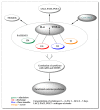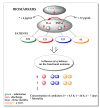Selected Mediators of Inflammation in Patients with Acute Ischemic Stroke
- PMID: 36142524
- PMCID: PMC9500922
- DOI: 10.3390/ijms231810614
Selected Mediators of Inflammation in Patients with Acute Ischemic Stroke
Abstract
During a stroke, a series of biochemical and metabolic changes occur which eventually lead to the death of cells by necrosis or apoptosis. This is a multi-stage process involving oxidative stress and an inflammatory response from the first signs of occlusion of a blood vessel until the late stages of regeneration and healing of ischemic tissues. The purpose of the research was to assess the concentration of pro-inflammatory cytokines IL-6 and TNF-α in the blood serum of patients with ischemic stroke (AIS) and to investigate their role as new markers in predicting functional prognosis after thrombolytic therapy. The researches have shown that the concentrations of the measured biomarkers were higher compared to the control group. Serum levels of IL-6 and THF-α before the initiation of intravenous thrombolysis were lower in the subgroup of patients with a favourable functional result (mRS: 0−2 pts) compared to the group of patients with an unfavourable functional result (mRS: 3−6 pts). A positive correlation was found between the concentration of IL-6 and TNF-α in patients with AIS during <4.5 h and on one day after the onset of stroke, which means that the concentration of IL-6 increases with the increase in TNF-α concentration. It has also been shown that higher levels of IL-6 in the acute phase of stroke and on the first and seventh days, and TNF-α during onset, were associated with poorer early and late prognosis in patients treated with intravenous thrombolysis. A relationship was found between the level of IL-6 and TNF-α in the subacute AIS and the severity of the neurological deficit. It has been shown that the investigated biomarkers may be a prognostic factor in the treatment of thrombolytic AIS.
Keywords: National Institutes of Health Stroke Scale; interleukin-6; ischemic stroke; modified Rankin Scale; tumor necrosis factor.
Conflict of interest statement
The authors declare no conflict of interest.
Figures







References
-
- Wein T., Lindsay M.P., Côté R., Foley N., Berlingieri J., Bhogal S., Bourgoin A., Buck B.H., Cox J., Davidson D., et al. Canadian stroke best practice recommendations: Secondary prevention of stroke, sixth edition practice guidelines, update 2017. Int. J. Stroke. 2018;13:420–443. doi: 10.1177/1747493017743062. - DOI - PubMed
-
- Lackland D.T., Roccella E.J., Deutsch A.F., Fornage M., George M.G., Howard G., Kissela B.M., Kittner S.J., Lichtman J.H., Lisabeth L.D., et al. Factors influencing the decline in stroke mortality: A statement from the American heart association/American stroke association. Stroke. 2014;45:315–353. doi: 10.1161/01.str.0000437068.30550.cf. - DOI - PMC - PubMed
-
- Benjamin E.J., Virani S.S., Callaway C.W., Szambelan A.M., Changa A.R., Cheng S., Chiuve S.E., Cushman M., Delling F.N., Deo R., et al. Heart disease and stroke statistics—2018 update: A report from the American Heart Association. Circ. Res. 2018;137:67–492. doi: 10.1161/CIR.0000000000000558. - DOI - PubMed
MeSH terms
Substances
LinkOut - more resources
Full Text Sources
Medical

